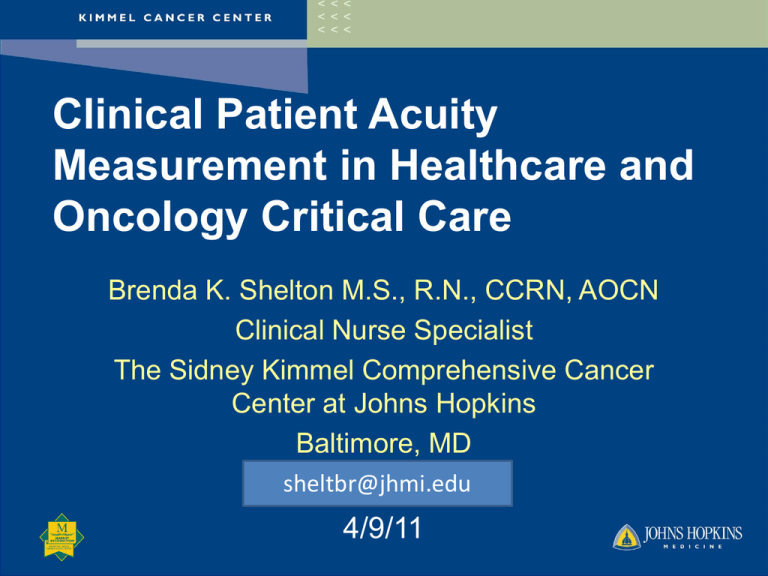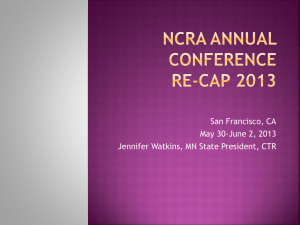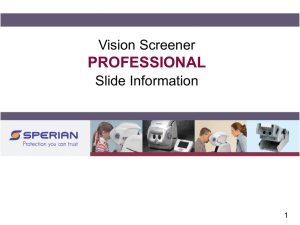Clinical Patient Acuity Measurement in Healthcare and Oncology
advertisement

Clinical Patient Acuity Measurement in Healthcare and Oncology Critical Care Brenda K. Shelton M.S., R.N., CCRN, AOCN Clinical Nurse Specialist The Sidney Kimmel Comprehensive Cancer Center at Johns Hopkins Baltimore, MD sheltbr@jhmi.edu sheltbr@jhmi.edu 4/9/11 Objectives • Evaluate acuity and prognostic scoring tools that have been researched for use in critically ill patients with cancer. • Identify challenges in implementation of acuity measurement instruments for oncology units. • Identify common clinical practice concerns of SIG meeting attendees. • Develop an education needs agenda for the SIG and 2011-2012 ONS conference attendees. Measurement of Acuity: The Problem • No uniform method of measurement has been established. • Acuity measures have not been translated to nursing intensity. • Acuity is anticipatory, current, and potential. • Measurement takes “time”, and there are no incentives. Types of Acuity Measurement Nursing Intensity • Focus on tasks which may vary according to setting, institutional geography, workflow processes. • Time oriented does not always reflect individual variation. • Does not usually effectively factor psychosocial and family dimensions. Patient Intensity • Focus on severity of illness for the patient. • Does not always differentiate needs met by professionals versus unlicensed personnel. • Many tools do not account for individual patient variations. Why does this remain a burning issue? There is consensus that we WANT acuity tools to assist in making assignments and determining nursing staffing. What WE want from acuity measurement tools is NOT what they claim to be able to do? Acuity Measurement in Oncology: State of the literature • Pubmed and CINAHL search 1980-20111 – Two existing published oncology inpatient instruments. – Critical illness prediction models includes cancer patients and validation with separate studies in cancer patients. • Acuity/ intensity nursing tools are available from forprofit companies. • “Oncology units” or specialty units dedicated to oncology (e.g. BMT) were NOT evaluated in the samples used to design California nursing staffing ratios. – Oncology Specialty units are noted as comparable examples to “step-down” areas. Oncology Acuity Models • Arenth (1985) – Dated – Small application for validation • Vanderbilt (2007) – More recent – Small application for validation – Unable to access for details Arenth Model of Oncology Patient Acuity (1985) • Oncology Specific. • Incorporated common oncology and critical illnesses. • Not current for today’s technology and inpatient population. • Does not differentiate high needs due to infection risk or self-care deficit from intermediate care (high dependency). Critical Care Acuity Models • • • • • • • • APACHE/ SAPS ICCM TISS MPM LOD SOFA MODS Interqual McKesson APACHE (Acute Physiology and Chronic Health Evaluation) • Versions I, II, III from original research with large volume of patients from a variety of settings. • Shortened version called SAPS-II (Simplified Acute Physiology Score). • Used for prognostication in critically ill. • Not accurate for individual patient assessment. • Time consuming to perform. • Most helpful when done repetitively. Intensive Care Mortality Model (ICMM) • Based upon APACHE instrument. • Cancer-specific variables incorporated. • Found to be predictive for mortality in most circumstances. – Not predictive in sepsis. – Most sensitive when done 72 hours after onset critical illness. • Shows important aggregate information. – Status of cancer is most predictive of survival. – Neutropenia does not predict for mortality. Therapeutic Index Scoring System (TISS28 or TISS-76) • Technology based rather than patient based. • At risk for bias based upon care that is chosen to be implemented. – Underpredicts critical illness in patients with cancer • Time-consuming to perform. Mortality Prediction Model (MPM-II, MPM-III) • Limited testing in patients with cancer. • Did not perform well with heterogenous populations. Mortality Prediction Models for Sepsis • Logistic Organ Failure (LOD) • Sequential Organ Failure Score (SOFA)* • Multiple Organ Dysfunction Score (MODS) • Identifies extremes of excellent and moribund prognosis. • Must be used sequentially for best performance- cancer patients often experience highest severity of illness 24-72 hours after onset critical illness. • Only SOFA performed well with patients having hematologic malignancy. Interqual McKesson (v2009) • Several different versions and criteria. – Cardiac, surgical, medical – Intermediate (IMC) or critical care • No single instrument developed from criteria. • Not clear that selection of criteria is evidence-based. • No oncology specific variables and unclear how to incorporate oncologic acuity. • Not studied to predict patient outcomes. • Used for determination of unit admission. • Used to predict and plan staffing ratios. Interqual McKesson- Sample IMC Criteria • • • • • • • • • • • • • Anti-infectives > 1 drug, initial two days Bicarbonate and pH < 7.25 IV medication and titration q 3-4 hours K < 2.5, < 3.0 with PVCs, > 6.0 KCl admin > 10 mEq/hr or > 120 mEq/L O2 > or = 40% (5L/min) for < or = 48 hrs Blood products > 2 products/24 hr (pooled products = 1) Clinical RN interventions more than q 4 hrs (e.g. assessment, complex skin care, CBI) Neuro assessments > 5 times/ 24 hr, initial 2 days Bleeding with any: chest pain, dyspnea, systolic BP < 30 mm from baseline, HR > 100, > 50 mL blood GVHD grades 2,3 (grade 4 classed as ICU) Wound care of at least 30 min > 2 X/24 hr Sepsis with any 2: T > 100.4 F or < 35.0 C, HR > 100/min, RR > 24/min, WBC > 12,000 or < 4000 Just when you think you’d like to bail out, someone else will be thinking…. “my what a great learning opportunity”







